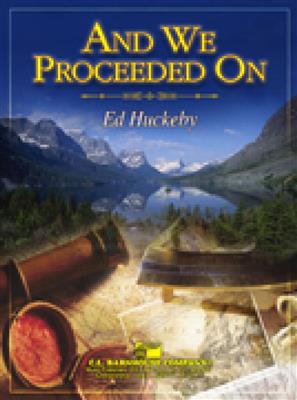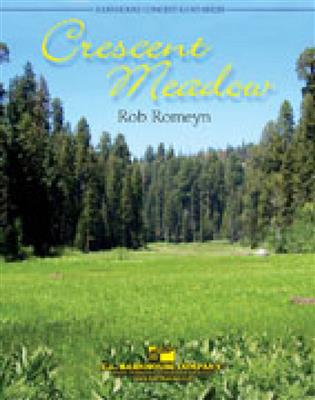Results
-
 £78.99
£78.99High Country Celebration - Earl
A vibrant composition by a young writer. An exciting piece that makes full use of all three instrument families and each gets several chances to shine. The Brass starts things off at an exciting Allegro Vivo tempo. An eloquent lyrical section includes short solos for Flute, Oboe, Clarinet and Alto Sax and all solos are amply cued to insure playability. Brilliantly scored to demonstrate a wide variety of tonal colors and there's lots of tasty percussion writing to challenge your entire section. An exceptional programming choice for any festival or concert performance. IMPRESSIVE!
Estimated dispatch 7-14 working days
-
 £78.99
£78.99And We Proceeded On - Ed Huckeby
Unique! This fresh exhilarating Ed Huckeby composition is an interpretive piece based on the Lewis and Clark Expedition of the early 19th century. Incorporating creative melodic ideas as well as experimental rhythmic concepts and instrumentation, this piece opens the door to new opportunities for creative performance. Includes flute (or recorder), oboe and tympani solos. A bold and exciting selection which your more advanced ensemble and audiences will love! Outstanding choice for concert or contest performance.
Estimated dispatch 7-14 working days
-
 £89.99
£89.99Rondo for Solo and Wind Band - Wolfgang Amadeus Mozart
For flute, oboe, clarinet, alto saxophone, bassoon, bass clarinet, trumpet or euphonium solo with band accompaniment.A tasteful arrangement of the third movement of Mozart's Bassoon Concerto which was chosen because the original solo would work so well with a large variety of wind instruments. The perfect setting to show off your top student no matter what they play! Wonderful music that will be an impressive addition to any concert!
Estimated dispatch 7-14 working days
-
 £74.99
£74.99Spirit of the Pioneers - Hillis
Featuring themes that evoke the spirit of the settlers moving westward, this delightful Greg Hillis composition is an exceptional choice for any mid-level band concert or contest performance. The adagio section begins with short solos for flute, clarinet, horn, bells and baritone (all are cued elsewhere) before building into a lush and powerful tutti. Full of appeal for audiences and players alike, this dynamic piece is sure to make your band sound like a million bucks!
Estimated dispatch 7-14 working days
-
 £91.99
£91.99In Pursuit of Troy - Shabazz
A impassioned work for better bands that displays the unique compositional style of Mississippi composer Ayatey Shabazz. Utilizing the full of range of colors of the modern symphonic band, this impressive piece will challenge all sections of your group to reach new heights in their musical journeys. Includes shorts solos for euphonium, bassoon, flute, trumpet and oboe. Tasty use of percussion helps to create varied musical emotions. Extremely nice!
Estimated dispatch 7-14 working days
-
 £71.50
£71.50Love's Old Sweet Song - Molloy
This beautiful song from the turn-of-the-century is Andrew Glover's latest addition to the Barnhouse "Spotlight" series for solo instrument or voice with band accompaniment. Most effective as a solo for euphonium, trombone, or cornet/trumpet, it includes solo parts and is also playable by solo flute, violin, oboe, clarinet, alto saxophone, or horn. It may also be performed as a vocal solo (medium range from low D up to top-line F.) A masterful arrangement of a wonderful classic song!
Estimated dispatch 7-14 working days
-
 £105.50
£105.50Legend of the Ancient Hero - Douglas Yeo
Dramatic and powerful, Legend of the Ancient Hero tells the musical story of a warrior in ancient times who risked his life to save his country from being conquered. Benjamin Yeo is a talented young composer from Singapore who has combined exciting rhythmic elements and a contrasting lyrical section that will make this programmatic work the highlight in your band concert, contest or festival performances! Solos for flute, trumpet and saxophone also provide opportunities to feature the best in your band. Simply exceptional!
Estimated dispatch 7-14 working days
-
 £78.99
£78.99Torrents of Fire - Larry Neeck
An inferno of excitement, "Torrents of Fire" will light-up your next concert program. Driving rhythms and aggressive percussion, balanced with bold, lyrical themes, provide a stunning variety of color and intensity. The contrasting middle section, with its optional flute solo and mallet percussion background, provides a hypnotic and sonorous contrast to the hard-driving nature of the rest of the piece. Perfect for concert or contest, "Torrents of Fire" will showcase your entire band with intensity and enthusiasm.
Estimated dispatch 7-14 working days
-
 £74.99
£74.99Crescent Meadow - Rob Romeyn
A beautiful and creative lyrical work for bands inspired by the composer's trip to California's Sequoia National Park, "Crescent Meadow" is an outstanding addition to the repertoire. The opening flute and clarinet solo fragments introduce a flowing melody amid varied harmonic textures, invoking vivid imagery of this beautiful meadow. A short section of contrasting style leads to a dramatic and breathtaking final statement. From there, the work subsides, ending as it began, with uncommon sensitivity. Ideal for concert or festival use, and very highly recommended!
Estimated dispatch 7-14 working days
-
 £78.99
£78.99Dream Chaser - Weller
Dream Chaser is a spirited concert opener for high school band that captures the energy and emotion of those who choose to follow their dreams in any walk of life. The buoyant melodies of the opening measures later give way to a powerful and expressive section with brief solo opportunities for flute, clarinet, alto saxophone, tenor saxophone, and baritone. The piece concludes with both main themes returning in an exciting, flourishing, finish. A dynamic work to build the synergy of your ensemble!
Estimated dispatch 7-14 working days
